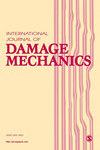A 3D failure criterion for damage assessment in composite T-joints under complex multiaxial stress status
IF 3.9
2区 工程技术
Q2 MATERIALS SCIENCE, MULTIDISCIPLINARY
引用次数: 0
Abstract
Composite T-joint application as a stiffener is a conjoint aspect in many thin-shell aero-structures; however, these structures are often prone to low-velocity impacts that can drastically reduce their load-carrying capacity. This article implements a new effective approach to determine damage sensitivity and progression. The first part includes a detailed assessment of the three-dimensional (3D) stress status and the result shows that the shear stresses substantially influence the deltoid matrix failure and skin-stiffener debonding. In the second part, a high-fidelity 3D damage model, with a modified damage initiation failure criterion based on Hashin and Puck is implemented via ABAQUS/EXPLICIT VUMAT user-subroutine. The intralaminar damage model considers 3D stress states and continuous stiffness degradation theory while for interlaminar failure, the cohesive-zone method based on bi-linear traction separation law is used. The mechanical response, as well as the intralaminar and interlaminar damage predicted by the model, shows a good correlation with the experimental findings. The results model shows a maximum error of 8% in the case of load versus time and a maximum error of 2.5% in the case of energy absorbed with the experimental results. Overall, the impact behavior of integrated composite structures can be effectively predicted using the recommended method.复合材料t形接头在复杂多轴应力状态下的三维破坏准则
复合材料t型接头作为加强筋是许多薄壳航空结构连接的一个方面;然而,这些结构往往容易受到低速撞击,从而大大降低其承载能力。本文实现了一种新的有效方法来确定损伤的敏感性和进展。第一部分包括对三维应力状态的详细评估,结果表明剪切应力对三角矩阵破坏和蒙皮加筋剥离有很大影响。第二部分通过ABAQUS/EXPLICIT VUMAT用户子程序实现了高保真三维损伤模型,并基于Hashin和Puck修正了损伤起裂失效准则。层间损伤模型考虑了三维应力状态和连续刚度退化理论,层间破坏采用基于双线牵引分离规律的黏结区方法。模型预测的力学响应以及层间和层内损伤与实验结果具有较好的相关性。计算结果表明,负荷对时间的最大误差为8%,能量吸收与实验结果的最大误差为2.5%。总体而言,采用推荐的方法可以有效地预测集成复合材料结构的冲击行为。
本文章由计算机程序翻译,如有差异,请以英文原文为准。
求助全文
约1分钟内获得全文
求助全文
来源期刊

International Journal of Damage Mechanics
工程技术-材料科学:综合
CiteScore
8.70
自引率
26.20%
发文量
48
审稿时长
5.4 months
期刊介绍:
Featuring original, peer-reviewed papers by leading specialists from around the world, the International Journal of Damage Mechanics covers new developments in the science and engineering of fracture and damage mechanics.
Devoted to the prompt publication of original papers reporting the results of experimental or theoretical work on any aspect of research in the mechanics of fracture and damage assessment, the journal provides an effective mechanism to disseminate information not only within the research community but also between the reseach laboratory and industrial design department.
The journal also promotes and contributes to development of the concept of damage mechanics. This journal is a member of the Committee on Publication Ethics (COPE).
 求助内容:
求助内容: 应助结果提醒方式:
应助结果提醒方式:


